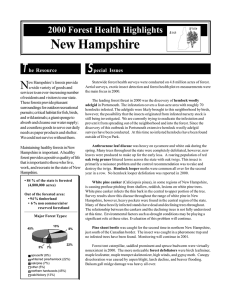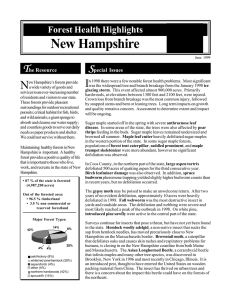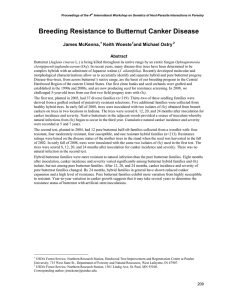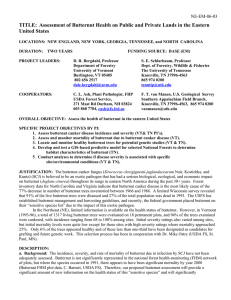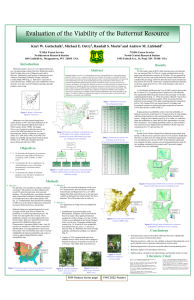New Hampshire N I
advertisement
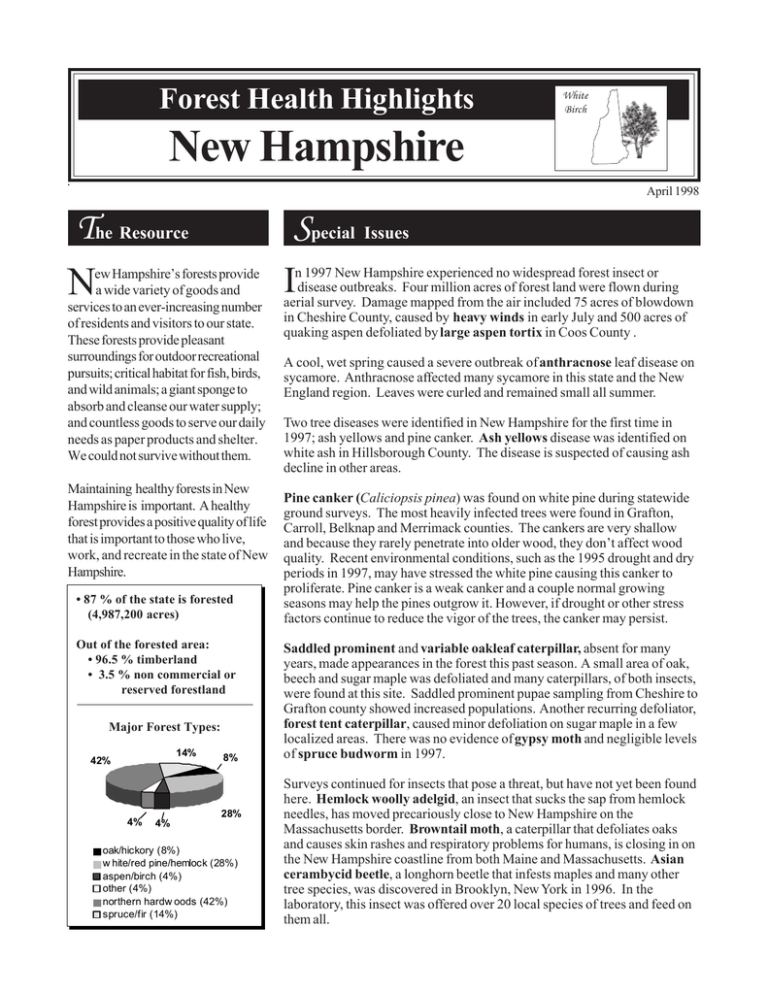
Forest Health Highlights White Birch New Hampshire April 1998 The Resource N ew Hampshire’s forests provide a wide variety of goods and services to an ever-increasing number of residents and visitors to our state. These forests provide pleasant surroundings for outdoor recreational pursuits; critical habitat for fish, birds, and wild animals; a giant sponge to absorb and cleanse our water supply; and countless goods to serve our daily needs as paper products and shelter. We could not survive without them. Maintaining healthy forests in New Hampshire is important. A healthy forest provides a positive quality of life that is important to those who live, work, and recreate in the state of New Hampshire. • 87 % of the state is forested (4,987,200 acres) Out of the forested area: • 96.5 % timberland • 3.5 % non commercial or reserved forestland Major Forest Types: 14% 42% 4% 4% 8% 28% oak/hickory (8%) w hite/red pine/hemlock (28%) aspen/birch (4%) other (4%) northern hardw oods (42%) spruce/fir (14%) Special Issues I n 1997 New Hampshire experienced no widespread forest insect or disease outbreaks. Four million acres of forest land were flown during aerial survey. Damage mapped from the air included 75 acres of blowdown in Cheshire County, caused by heavy winds in early July and 500 acres of quaking aspen defoliated by large aspen tortix in Coos County . A cool, wet spring caused a severe outbreak of anthracnose leaf disease on sycamore. Anthracnose affected many sycamore in this state and the New England region. Leaves were curled and remained small all summer. Two tree diseases were identified in New Hampshire for the first time in 1997; ash yellows and pine canker. Ash yellows disease was identified on white ash in Hillsborough County. The disease is suspected of causing ash decline in other areas. Pine canker (Caliciopsis pinea) was found on white pine during statewide ground surveys. The most heavily infected trees were found in Grafton, Carroll, Belknap and Merrimack counties. The cankers are very shallow and because they rarely penetrate into older wood, they don’t affect wood quality. Recent environmental conditions, such as the 1995 drought and dry periods in 1997, may have stressed the white pine causing this canker to proliferate. Pine canker is a weak canker and a couple normal growing seasons may help the pines outgrow it. However, if drought or other stress factors continue to reduce the vigor of the trees, the canker may persist. Saddled prominent and variable oakleaf caterpillar, absent for many years, made appearances in the forest this past season. A small area of oak, beech and sugar maple was defoliated and many caterpillars, of both insects, were found at this site. Saddled prominent pupae sampling from Cheshire to Grafton county showed increased populations. Another recurring defoliator, forest tent caterpillar, caused minor defoliation on sugar maple in a few localized areas. There was no evidence of gypsy moth and negligible levels of spruce budworm in 1997. Surveys continued for insects that pose a threat, but have not yet been found here. Hemlock woolly adelgid, an insect that sucks the sap from hemlock needles, has moved precariously close to New Hampshire on the Massachusetts border. Browntail moth, a caterpillar that defoliates oaks and causes skin rashes and respiratory problems for humans, is closing in on the New Hampshire coastline from both Maine and Massachusetts. Asian cerambycid beetle, a longhorn beetle that infests maples and many other tree species, was discovered in Brooklyn, New York in 1996. In the laboratory, this insect was offered over 20 local species of trees and feed on them all. Special Issues cont. B eginning on January 8, 1998 an ice glazing storm injured trees in an area encompassing 3.4 million acres or 60% of the state. Based on aerial survey and ground checking, it is estimated as many as 900,000 acres received injury ranging from light to heavy severity. The ice caused bending and uprooting of trees, and branch and stem breakage. Hardwoods, such as maples, beech, aspen and oak, were the primary species injured at elevations ranging from 900 feet in the south to 1300 feet in the northern portion of the state. In the short term, favorable growing conditions and the trees natural ability to wall off injury will help mitigate damage. Long term impacts on growth and quality remain a concern. Assessment to determine extent and impact will be ongoing. SPECIAL PROJECT Since 1995, butternut trees have been surveyed for butternut canker; a disease that has killed butternuts from Wisconsin to Maine. More than 90% of the butternuts found in NH are infected with the canker causing fungus Sirococcus clavigignentijuglandacearum. This tree is important for forest biodiversity and the Division of Forests and Lands has initiated a grafting project to save this species from the same plight as american chestnut and american elm. In 1997 a total of 117 scions (butternut branches), collected from twelve “super trees”, were grafted to walnut rootstock. Fifty-six percent of those grafted seedling survived and there are surviving grafts from all twelve “super trees”. These grafted seedlings will be planted in a seed orchard at the State Forest Nursery. Our goal is to have nut production and a healthy scion source that will be used to grow butternuts with high resistance to the disease. R egional Surveys I nterest in regional forest condition prompted the implementation of the National Forest Health Monitoring Program and the North American Maple Project. Forest Health Monitoring Sites FOREST HEALTH MONITORING PROGRAM The objective is to assess trend in tree condition and forest stressors. All of the New England States have been involved since the program was initiated in 1990. Results indicate that there has been minimal change in crown condition in the last 8 years. In 1997, about 98 percent of trees greater than 5 inches diameter had normal crown fullness. About 97 percent of the trees had little or no crown dieback, and 78 percent showed no measurable signs of damage. The most common damage was decay indicators, which were more evident on hardwoods than softwoods. Additional surveys indicate there are concerns for individual species such as ash, butternut, and hemlock due to various damage agents. NORTH AMERICAN MAPLE PROJECT This cooperative project with Canada was initiated in 1988 to look at change in sugar maple tree condition. There are several states in the Northeast involved including New York, New Hampshire, Vermont, Maine, and Massachusetts. Overall, sugar maple located within the sample sites are in good condition. Periodically, insect defoliation has affected crown condition in some areas. There was little difference found between sugarbush and non sugarbush stands. F or More Information Or To Report Forest Damage Contact: NH Dept. of Resources & Economic Development Division of Forests and Lands Insect and Disease Section P.O. Box 1856 Concord, NH 03302 Forest Health Protection USDA Forest Service P.O. Box 640 Durham, NH 03824 (603) 868-7709 (603) 271-7858 State and Private Forestry

